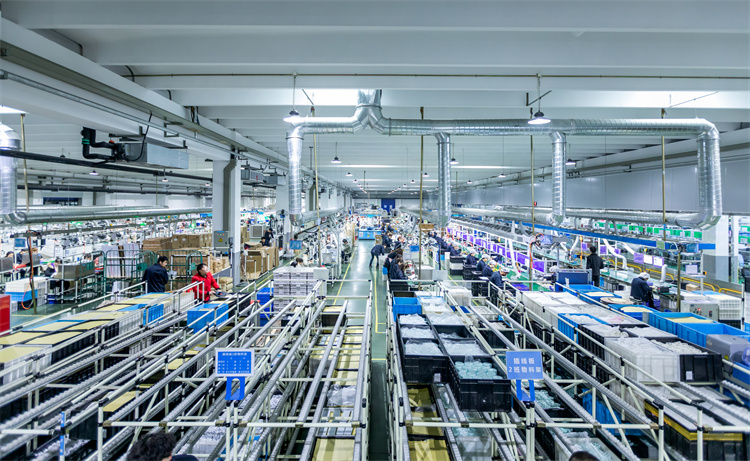How AI Tools Improve Operational Efficiency in 2025

AI is transforming business operations, enhancing automation, predictions, and decision-making. By 2025, 72% of companies are expected to utilize AI in at least one area. Factories can reduce costs by up to 32%, while marketing sees a revenue increase of 6–10%. The integration of AI tool operation accelerates workflows and improves overall efficiency.
Key Takeaways
AI tools handle boring tasks, cutting mistakes and boosting work by 30%. This makes work faster and more accurate.
Predictive maintenance stops machines from breaking, saving time and cash. It helps machines work well and last longer.
Adding AI to supply chains improves teamwork and saves money. Live tracking and guessing demand help businesses plan better.
Key Areas Where AI Enhances Operational Efficiency

Process Automation in Supply Chains
Automation has changed supply chains by handling repetitive tasks. It also reduces mistakes made by humans. Tasks like managing inventory, processing orders, and tracking shipments are now automated. This makes work faster and more accurate. For example, a factory in Ohio improved productivity by 30% using robots. A financial company in London cut processing time by 40% with machine learning. These examples show how automation saves money and boosts efficiency.
Evidence Type | Statistic |
|---|---|
Average efficiency boost | 20-30% increase |
Productivity increase in manufacturing | 30% increase |
Reduction in processing time | 40% decrease |
Projected productivity gains with AI | Up to 40% over the next decade |
Predictive Maintenance for Equipment Longevity
Predictive tools help keep machines working longer. Sensors and past data predict problems before they happen. This reduces downtime and keeps equipment running smoothly. For example, factories use predictive maintenance to avoid sudden breakdowns. It also helps save money and time by using resources wisely.
AI-Driven Supply Chain Optimization with JUSDA
JUSDA uses AI to improve supply chains. Its platform lowers costs and helps teams work better together. The system predicts demand and tracks shipments in real time. This helps businesses make smart decisions. JUSDA’s technology makes supply chains more efficient and saves money.
JUSDA's AI lowers production costs.
It improves teamwork in supply chains.
The system makes supply chains better.
Quality Control Through AI Technology
AI helps find mistakes early in quality checks. This reduces waste and improves product quality. For instance, AI found 20 issues in 90 days, saving $4.5 million in engine repairs. This method makes work smoother and increases productivity.
Enhancing Customer Service with AI Tools
AI tools make customer service faster and more accurate. Chatbots and voice assistants answer questions quickly, making customers happy. Metrics like First Contact Resolution (FCR) and Net Promoter Score (NPS) improve with AI. For example, a telecom company boosted agent productivity by 20% using AI tools.
Improvement Type | Metric Change | Description |
|---|---|---|
First Contact Resolution (FCR) | Increased by 78% | A client using Mediatel's voicebot reduced follow-up calls. |
Agent Productivity | Increased by 20% | A telecom company improved agent work with AI assistance. |
Customer Satisfaction (Video Calls) | 83.64% high satisfaction | A bank's video onboarding made customers happy and comfortable. |

AI Technologies Driving Operational Improvements

Machine Learning for Predictive Analytics
Machine learning helps businesses make smarter choices. It studies big data quickly and accurately. This allows companies to predict trends, spot risks, and use resources wisely. For example, businesses check old data to find possible problems. This avoids expensive errors and improves planning.
Machine learning gives instant insights for better choices.
Predictive tools help use resources in smart ways.
Risk checks are more accurate with past data.
Example Description | Improvement Percentage |
|---|---|
Faster processing time with machine learning | |
Better overall efficiency for businesses | 40% |

Natural Language Processing in Customer Interactions
Natural language processing (NLP) makes talking to customers easier. Chatbots and virtual helpers give quick and correct answers. This makes customers happier and saves time. For example, companies saw a 78% boost in solving issues on the first try with smart systems.
Customer Satisfaction Score (CSAT) gets better with personal replies.
Average Handle Time (AHT) drops with faster workflows.
Customer Effort Score (CES) lowers as self-help tools make tasks simple.
These tools give customers faster and better service.
Computer Vision for Quality Assurance
Computer vision changes how products are checked for quality. It finds problems fast and fixes them right away. This cuts waste and ensures high-quality items. For example, a chip company found 90% more defects and saved 50% on labor costs.
Improvement Type | Description |
|---|---|
Finds problems quicker and better than people. | |
Surface Checks | Spots flaws in surfaces to stop bad products. |
Less Waste and Rework | Saves materials and money by catching issues early. |
Computer vision keeps quality high, making customers happy and cutting costs.
Robotic Process Automation in Warehousing Operations
Robotic process automation (RPA) makes warehouse work faster and easier. It handles tasks like tracking stock and filling orders. This reduces mistakes and speeds up work. For example, RPA improves stock accuracy and moves goods faster.
Metric | Description |
|---|---|
Lower Labor Costs | Cuts spending on managing workers. |
Higher Throughput | Moves more goods in less time. |
Better Stock Accuracy | Tracks and manages inventory more precisely. |
RPA makes warehouses more efficient and speeds up deliveries.
Overcoming Challenges in AI Implementation
Ensuring Data Quality and Availability
Good data is key for AI to work well. If data is wrong or missing, AI tools may fail. Data must be correct, complete, and up-to-date. For example, old or incomplete data can lead to bad results. By keeping data accurate, decisions and efficiency improve.
Key ways to check data quality:
Accuracy: Data matches real-world facts.
Completeness: All needed data is included.
Consistency: Data stays the same across systems.
Timeliness: Data is current when used.
Validity: Data meets required rules.
These checks ensure data stays reliable for AI success.
System Integration Across Platforms
Connecting AI tools to current systems can be hard. Many companies struggle with linking ERP, CRM, and WMS platforms. When done right, integration improves data flow and boosts work speed. For example, a chip maker found 90% more defects and cut labor costs by 50%. An airline also reduced delays by 30% using predictive AI.
To succeed, use open data links and unified systems. This makes integration easier and helps get the most from AI.
Employee Training for AI Tool Operation
Workers need training to use AI tools well. Without it, AI investments may not pay off. Training teaches workers how to handle AI confidently. For example, change management helps ease worries and supports smooth tool adoption.
Training helps teams work better with AI. It increases productivity and builds a culture of innovation.
Addressing Ethical and Privacy Concerns
AI faces problems like bias and unclear decisions. These issues can harm trust and lead to mistakes. To fix this, use tools to find bias and explain AI actions. Teaching workers to use AI responsibly also reduces risks.
Privacy is important too. AI must follow data protection laws to keep information safe. By being ethical, you ensure AI works fairly and matches company values.

JUSDA Solutions
To provide you with professional solutions and quotations.
AI tools are changing how industries work and grow. New ideas like Edge AI and Explainable AI will improve automation and clarity. Businesses using AI tools, like JUSDA, see great results. They get 78% better at predicting needs and improve inventory use. This shows how processes are becoming smarter for the future.
FAQ
What is predictive maintenance, and how does it work?
Predictive maintenance uses AI to check machines for problems. It studies sensor data to find issues early. This stops breakdowns and saves money.
How can predictive maintenance improve operational efficiency?
It avoids sudden machine failures and makes equipment last longer. Fixing problems early keeps work smooth and lowers repair costs.
Why should you invest in predictive maintenance tools?
These tools cut downtime and repair expenses, saving money. They also boost productivity by keeping machines working well and reliably.
